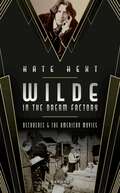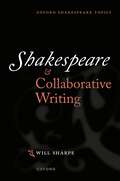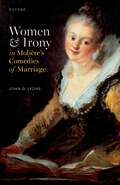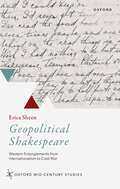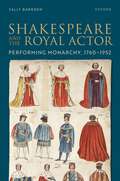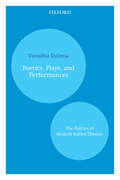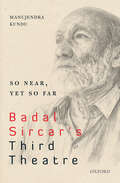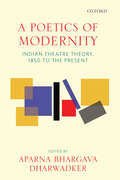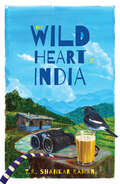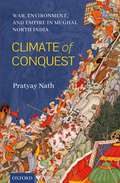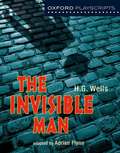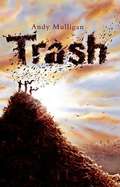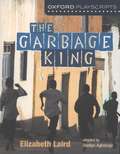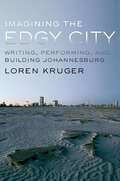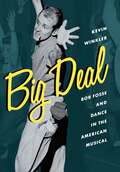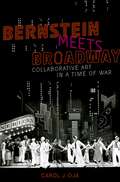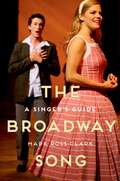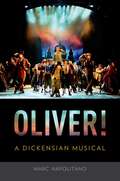- Table View
- List View
Oxford Reading Tree, Level 17, TreeTops Classics, Pack A: Macbeth (PDF)
by William Shakespeare Jon BlakeBook band 15 dark red. Oxford level 17, pack A. Macbeth is the story of a noble and courageous man, Macbeth, who is happy to serve King Duncan. A chance meeting plants the seed of ambition in Macbeth's mind. Gripped with the same ambition, Lady Macbeth pushes her husband to gain power, with terrible consequences. Exciting and powerful classic stories to enrich and extend your children's reading experiences. TreeTops Classics are carefully adapted versions of must-read stories which introduce your readers to significant authors, powerful plots and characters that have stood the test of time. These abridgedversions of classics have been sensitively adapted by top children's authors to ensure that language and content is appropriate, but remain faithful to the original. These enchanting stories will appeal to all your junior readers and introduce them to a rich literary heritage. Each book includesauthor biographies and notes to help with historical and social context and any challenging vocabulary, ensuring the books are easily accessible. Books contain inside cover notes to support children in their reading. Help with children's reading development also available at www. oxfordowl. co. uk. The books are finely levelled, making it easy to match every child to the right book.
Wilde in the Dream Factory: Decadence and the American Movies
by Kate HextHollywood is haunted by the ghost of playwright and novelist Oscar Wilde. This is the story of his haunting, told for the first time. Set within the rich evolving context of how the American entertainment industry became cinema, and how cinema become the movies, it reveals how Wilde helped to shape Hollywood in the early twentieth century. It begins with his 1882 American tour, and traces the ongoing popularity of his plays and novel in the early twentieth century, after his ignominious death. Following the early filmmakers, writers and actors as they headed West in the Hollywood boom, it uncovers how and why they took Wilde's spirit with them. There, in Hollywood, in the early days of silent cinema, Wilde's works were adapted. They were also beginning to define a new kind of style -- a 'Wilde-ish spirit', as Ernst Lubitsch called it -- filtering into the imaginations of Lubitsch himself, as well as Alla Nazimova, Ben Hecht, Samuel Hoffenstein and many others. These were the people who translated Wilde's queer playfulness into the creation of screwball comedies, gangster movies, B-movie horrors, and films noir. There, Wilde and his style embodied a spirit of rebellion and naughtiness, providing a blue-print for the charismatic cinematic criminal and screwball talk onscreen. Discussing films including Bringing Up Baby, Underworld, and Laura, alongside definitive adaptations of Wilde's works, including, The Picture of Dorian Gray, Lady Windermere's Fan, and Salome, Wilde in the Dream Factory revises how we understand both Wilde's afterlife and cinema's beginnings.
Shakespeare & Collaborative Writing (Oxford Shakespeare Topics)
by Dr Will SharpeShakespeare and Collaborative Writing offers a rich account of Shakespeare's artistic development in, against, and beyond collaboration. We see him afresh as a poetic innovator in continual flux, and in continual artistic debt: an author shaped by others in a collaborative network of intellectual influence and dynamic interchange, and, the book argues, one that he helped substantially to create. In considering collaboration as a practice defining almost all of his earliest works, it shows that he was particularly active in its development in the early theatre scene of his nascent career, changing our sense of his development as a creative artist quite radically. Chapters exploring collaboration via theatre history, book history, and attribution debates complement the central three chapters detailing the different phases of Shakespeare's collaborative work, which reorient our shifting sense of what it meant to him, and what he gained from it, at these other key moments of his artistic career. In reconstructing the circumstances and outcomes of his pairings with other dramatists, and scrutinizing more closely their artistic contributions, Shakespeare and Collaborative Writing reconsiders the ways in which they influenced and challenged him to adapt and experiment with his writing in ways that go beyond the features of his solo-authored canon. In undertaking a rigorous appreciation of the structures and poetics of his co-authored works, this book presents them as distinctive works of art that transform our understanding of Shakespeare the poet, dramatist, and enduring cultural icon.
Shakespeare & Collaborative Writing (Oxford Shakespeare Topics)
by Dr Will SharpeShakespeare and Collaborative Writing offers a rich account of Shakespeare's artistic development in, against, and beyond collaboration. We see him afresh as a poetic innovator in continual flux, and in continual artistic debt: an author shaped by others in a collaborative network of intellectual influence and dynamic interchange, and, the book argues, one that he helped substantially to create. In considering collaboration as a practice defining almost all of his earliest works, it shows that he was particularly active in its development in the early theatre scene of his nascent career, changing our sense of his development as a creative artist quite radically. Chapters exploring collaboration via theatre history, book history, and attribution debates complement the central three chapters detailing the different phases of Shakespeare's collaborative work, which reorient our shifting sense of what it meant to him, and what he gained from it, at these other key moments of his artistic career. In reconstructing the circumstances and outcomes of his pairings with other dramatists, and scrutinizing more closely their artistic contributions, Shakespeare and Collaborative Writing reconsiders the ways in which they influenced and challenged him to adapt and experiment with his writing in ways that go beyond the features of his solo-authored canon. In undertaking a rigorous appreciation of the structures and poetics of his co-authored works, this book presents them as distinctive works of art that transform our understanding of Shakespeare the poet, dramatist, and enduring cultural icon.
Women and Irony in Molière's Comedies of Marriage
by Prof John D. LyonsThis is a book about how Molière, France's most celebrated author of comedies, made something strikingly new out of the traditional comedy plot of thwarted courtship. Though justly celebrated for his mastery of physical comedy and farce, one of Molière's key moves was to pay attention to the way women could use language. Seventeenth-century France was a time when speaking well became exceptionally important, and in this arena women were the trend-setters. Among the most important places to display taste and social skills were the salons, gatherings presided over by women. Yet women still enjoyed little in the way of rights, particularly regarding a central decision in their lives: the choice of a husband. French regulations of marriage contracts became increasingly restrictive, largely to the detriment of women. To draw attention to their plight, women novelists and essayists presented case studies in how men and women misunderstood one another, how women were coerced to wed, how marriages could become nightmares, and how courtships could fail. Against this fraught social background Molière showed women using one of the few assets they had, their mastery of words, and in particular the rhetoric of irony, to frustrate the plans of fathers, guardians, and other authority figures. The comedies discussed here include very well-known plays such as The Misanthrope, Tartuffe, The Learned Ladies, The School for Wives and Don Juan, and also less known but revealing and thought-provoking works such as The School for Husbands, George Dandin and Monsieur de Pourceaugnac.
Women and Irony in Molière's Comedies of Marriage
by Prof John D. LyonsThis is a book about how Molière, France's most celebrated author of comedies, made something strikingly new out of the traditional comedy plot of thwarted courtship. Though justly celebrated for his mastery of physical comedy and farce, one of Molière's key moves was to pay attention to the way women could use language. Seventeenth-century France was a time when speaking well became exceptionally important, and in this arena women were the trend-setters. Among the most important places to display taste and social skills were the salons, gatherings presided over by women. Yet women still enjoyed little in the way of rights, particularly regarding a central decision in their lives: the choice of a husband. French regulations of marriage contracts became increasingly restrictive, largely to the detriment of women. To draw attention to their plight, women novelists and essayists presented case studies in how men and women misunderstood one another, how women were coerced to wed, how marriages could become nightmares, and how courtships could fail. Against this fraught social background Molière showed women using one of the few assets they had, their mastery of words, and in particular the rhetoric of irony, to frustrate the plans of fathers, guardians, and other authority figures. The comedies discussed here include very well-known plays such as The Misanthrope, Tartuffe, The Learned Ladies, The School for Wives and Don Juan, and also less known but revealing and thought-provoking works such as The School for Husbands, George Dandin and Monsieur de Pourceaugnac.
Geopolitical Shakespeare: Western Entanglements from Internationalism to Cold War (Oxford Mid-Century Studies Series)
by Erica SheenGeopolitical Shakespeare: Western Entanglements from Internationalism to Cold War examines the entanglement of Shakespearean culture in the geopolitical dynamics of the post-war West. Taking its cue from a speech given by Albert Einstein in London in 1933, in which Shakespeare is cited as an example of the Western value of personal and intellectual freedom, this book explores a series of events between 1945 and 1955 featuring key historical figures--scientists, international lawyers, diplomats and politicians, writers, actors, and filmmakers--who experienced the tensions of the early Cold War through Shakespeare, or called on him to articulate this new post-war world. Erica Sheen examines political, diplomatic, cultural, and economic interactions within 'core' Western power relations--the USA, UK, and Europe, with particular reference to Germany--in which Shakespeare, or the idea of Shakespeare, was entangled in the struggle for new ideas and social structures. The subjects of this book include John Humphrey and the drafting of the Universal Declaration of Human Rights; the Nuremberg Trials and the foundation of West Germany; Noel Annan and the Berlin Elizabethan Festival; an American production of Hamlet in Elsinore; Laurence Olivier, David Selznick, and the Shakespeare film in post-war Hollywood; Graham Greene and The Third Man; and Carl Schmitt and Salvador de Madariaga on Hamlet in post-war Europe. In each of these case studies, Sheen discovers a Shakespeare for our time: engaged in contestations of territoriality in cultures of international law and human rights, theatre, film, and literature.
Geopolitical Shakespeare: Western Entanglements from Internationalism to Cold War (Oxford Mid-Century Studies Series)
by Erica SheenGeopolitical Shakespeare: Western Entanglements from Internationalism to Cold War examines the entanglement of Shakespearean culture in the geopolitical dynamics of the post-war West. Taking its cue from a speech given by Albert Einstein in London in 1933, in which Shakespeare is cited as an example of the Western value of personal and intellectual freedom, this book explores a series of events between 1945 and 1955 featuring key historical figures--scientists, international lawyers, diplomats and politicians, writers, actors, and filmmakers--who experienced the tensions of the early Cold War through Shakespeare, or called on him to articulate this new post-war world. Erica Sheen examines political, diplomatic, cultural, and economic interactions within 'core' Western power relations--the USA, UK, and Europe, with particular reference to Germany--in which Shakespeare, or the idea of Shakespeare, was entangled in the struggle for new ideas and social structures. The subjects of this book include John Humphrey and the drafting of the Universal Declaration of Human Rights; the Nuremberg Trials and the foundation of West Germany; Noel Annan and the Berlin Elizabethan Festival; an American production of Hamlet in Elsinore; Laurence Olivier, David Selznick, and the Shakespeare film in post-war Hollywood; Graham Greene and The Third Man; and Carl Schmitt and Salvador de Madariaga on Hamlet in post-war Europe. In each of these case studies, Sheen discovers a Shakespeare for our time: engaged in contestations of territoriality in cultures of international law and human rights, theatre, film, and literature.
Shakespeare and the Royal Actor: Performing Monarchy, 1760-1952
by Sally BarndenShakespeare and the Royal Actor argues that members of the royal family have identified with Shakespearean figures at various times in modern history to assert the continuity, legitimacy, and national identity of the royal line. It provides an account of the relationship between the Shakespearean afterlife and the royal family through the lens of a broadly conceived theatre history suggesting that these two hegemonic institutions had a mutually sustaining relationship from the accession of George III in 1760 to that of Elizabeth II in 1952. Identifications with Shakespearean figures have been deployed to assert the Englishness of a dynasty with strong familial links to Germany and to cultivate a sense of continuity from the more autocratic Plantagenet, Tudor, and Stuart monarchs informing Shakespeare's drama to the increasingly ceremonial monarchs of the modern period. The book is driven by new archival research in the Royal Collection and Royal Archives. It reads these archives critically, asking how different forms of royal and Shakespearean performance are remembered in the material holdings of royal institutions.
Shakespeare and the Royal Actor: Performing Monarchy, 1760-1952
by Sally BarndenShakespeare and the Royal Actor argues that members of the royal family have identified with Shakespearean figures at various times in modern history to assert the continuity, legitimacy, and national identity of the royal line. It provides an account of the relationship between the Shakespearean afterlife and the royal family through the lens of a broadly conceived theatre history suggesting that these two hegemonic institutions had a mutually sustaining relationship from the accession of George III in 1760 to that of Elizabeth II in 1952. Identifications with Shakespearean figures have been deployed to assert the Englishness of a dynasty with strong familial links to Germany and to cultivate a sense of continuity from the more autocratic Plantagenet, Tudor, and Stuart monarchs informing Shakespeare's drama to the increasingly ceremonial monarchs of the modern period. The book is driven by new archival research in the Royal Collection and Royal Archives. It reads these archives critically, asking how different forms of royal and Shakespearean performance are remembered in the material holdings of royal institutions.
Poetics, Plays, and Performances: The Politics of Modern Indian Theatre
by Vasudha DalmiaThis book addresses the political and aesthetic concerns of modern Indian theatre, tracing its genealogies, and looking in particular at its appropriation of 'folk' theatre. Starting with the plays of Bharatendu Harishchandra in 1870s Banaras, the book moves forward to Jayshankar Prasad and Mohan Rakesh, landmark figures in the history of modern Indian drama. Dalmia then focuses on the intense urban interaction with folk theatre forms, their politicization in the 1940s and later again in the 1970s. Finally the book maps some of the routes taken by avant-garde women directors since the last decades of the twentieth century. Theatre students, critics, cultural historians, scholars of South Asian theatre, as well as general readers will find the book inspiring.
So Near, Yet So Far: Badal Sircar’s Third Theatre
by Manujendra KunduThis is the first-ever, full-length study of Badal Sircar's Third Theatre. Sircar was a very prominent playwright of modern Bengali Theatre. It challenges some of the well-established notions of the Third Theatre. It brings to the fore the lost voices of some members of the Third Theatre. It has some rare photographs of Shatabdi, Sircar's Theatre group.
A Poetics of Modernity: Indian Theatre Theory, 1850 to the Present
by Aparna Bhargava DharwadkerThe urban theatre which emerged under Anglo-European and local influences in colonial metropolises such as Calcutta and Bombay around the mid-nineteenth century marked the beginning of the ‘modern period’ in Indian theatre, distinct from classical, postclassical, and more proximate precolonial traditions. A Poetics of Modernity offers a unique selection of original, theoretically significant writings on theatre by playwrights, directors, actors, designers, activists, and policy–makers, to explore the full range of discursive positions that make these urban practitioners ‘modern’. The source-texts represent nine languages, including English, and about one-third of them have been translated into English for the first time; the volume thus retrieves a multilingual archive that so far had remained scattered in print and manuscript sources around the country. A comprehensive introduction by Dharwadker argues for historically precise definitions of theatrical modernity, outlines some of its constitutive features, and connects it to the foundational theoretical principles of urban theatre practice in modern India.
The Wild Heart of India: Nature and Conservation in the City, the Country, and the Wild
by T.R. Shankar RamanWild—untamed, hostile, remote. Yet, wild can be gentle, welcoming, and inspiring, too. This is the wild that preoccupies biologist Shankar Raman as he writes about trees and bamboos, hornbills and elephants, leopards and myriad other species. Species found not just out there in far wildernesses—from the Thar desert to the Kalakad rainforests, from Narcondam Island to Namdapha—but amid us, in gardens and cities, in farms, along roadsides. And he writes about the forces that gouge land and disfigure landscapes, rip trees and shred forests, pollute rivers and contaminate the air, slaughter animals along roads and rail tracks—impelling a motivation to care, and to conserve nature. Through this collection of essays, Shankar Raman attempts to blur, if not dispel, the sharp separation between humans and nature, to lead you to discover that the wild heart of India beats in your chest, too.
Climate of Conquest: War, Environment, and Empire in Mughal North India
by Pratyay NathWhat can war tell us about empire? In Climate of Conquest, Pratyay Nath seeks to answer this question by focusing on the Mughals. He goes beyond the traditional way of studying war in terms of battles and technologies. Instead, he unravels the deep connections that the processes of war-making shared with the society, culture, environment, and politics of early modern South Asia. Climate of Conquest closely studies the dynamics of the military campaigns that helped the Mughals conquer North India and project their power beyond it. The author argues that the diverse natural environment of South Asia deeply shaped Mughal military techniques and the course of imperial expansion. He also sheds light on the world of military logistics, labour, animals, and the organization of war; the process of the formation of imperial frontiers; and the empire’s legitimization of war and conquest. What emerges is a fresh interpretation of Mughal empire-building as a highly adaptive, flexible, and accommodative process.
Oxford Playscripts: The Invisible Man (PDF)
by Adrian FlynnBlending science fiction with the dangers of human ambition, this is a story of scientific discovery turned nightmare. There are many whispered questions when medical student Griffin arrives at a small village wrapped in bandages; however, no one can guess the true reason for his disguise. Terror, revenge and chaos ensue as Griffin, and those around him, come to terms with the effects of his latest experiment.
Rollercoasters: Trash (PDF)
by Andy MulliganSoon to be made into a film, Raphael, Gardo and Rat are three street kids who sort through mountains of trash for anything they can sell or recycle. When they come across a mysterious bag amongst the rubbish, containing a key and a wallet, they are soon on the run, using their wits and quick tongues to stay ahead of the police.
Oxford Playscripts: The Garbage King (PDF)
by Elizabeth Laird Oladipo AgboluajeAn engaging classroom playscript. Seeking shelter in a desolate graveyard, Mamo stumbles upon Dani, a fellow fugitive in the dangerous city of Addis Ababa. Both boys are desperately trying to outrun their past: Mamo has escaped the horrors of slavery while Dani has sacrificed a life of luxury by running away from his domineering father. Forced to live and work on a dumpsite in order to survive, just how long can they run before their pasts catch up with them?
Shakespeare: An Oxford Guide
by Stanley Wells Lena Cowen OrlinEdited by Stanley Wells and Lena Cowen Orlin, this stimulating and comprehensive guide to Shakespeare is an ideal text for undergraduate students. It includes over forty specially commissioned essays by an outstanding team of scholars. Each essay is written in an accessible and engaging style and is followed by annotated suggestions for further reading. Shakespeare: An Oxford Guide is divided into four key parts. Part One offers concise introductions to the literary and historical contexts in which Shakespeare lived and worked. It covers the society, culture, language, theatre, and playwriting conventions of Shakespeare's time and also discusses his contemporary impact. Part Two offers critical overviews of Shakespeare's achievements in the major genres. Each overview is followed by a reading that explores Shakespeare's use of the traditions, scope, and boundaries of that genre in one of his key works. Part Three discusses current critical approaches to the study of Shakespeare. Each chapter outlines a specific approach and is followed by a reading applying that approach to one of Shakespeare's works. Part Four offers chapters on Shakespeare's intellectual and cultural impact over the ages.
Imagining the Edgy City: Writing, Performing, and Building Johannesburg
by Loren Kruger"All roads lead to Johannesburg," remarks the narrator of Alan Paton's novel Cry, The Beloved Country. Taking this quote as her impetus, Loren Kruger guides readers into the heart of South Africa's largest city. Exploring a wide range of fiction, film, architecture, performance, and urban practices from trading to parades, Imagining the Edgy City traverses Johannesburg's rich cultural terrain over the last century. The "edgy city" in Kruger's exploration refers not only to persistent boundaries between the haves and have-nots but also to the cosmopolitan diversity and innovation that has emerged from Johannesburg. The book begins with the building boom, performances and uneven but noteworthy inter-racial exchange that marked the city's fiftieth-anniversary celebration at the Empire Exhibition in 1936. This celebration rapidly gave way to the political repression and civil unrest that characterized South Africa from 1950 to 1990. Yet poetry, drama, fiction, and photography continued to thrive, bearing witness not only against apartheid but to alternatives beyond it. In the late twentieth century, the not quite post-apartheid condition fired the artistic imaginations of film makers as well as novelists. Urban neglect, rising crime, and the influx of migrants inspired noir cinema-like Michael Hammon's Wheels and Deals-and fiction about migration from Achmat Dangor to Phaswane Mpe, and in the twenty-first, urban renewal has produced public art that incorporates the desire lines of newcomers as well as natives. Alongside well-known artists such as Nadine Gordimer, William Kentridge, and David Goldblatt, the book introduces many artists, architects, writers, and other chroniclers who have hitherto received little attention abroad. Ultimately, Johannesburg emerges as a city whose negotiation of the tensions between incivility and innovation invites comparisons with modern conurbations across the world, not only African cities such as Dakar, or other cities of the "south" such as Bogotá, but also with major metropolises in North America and Europe from Chicago to Paris. A multi-faceted work that speaks to scholars in urban studies, literature, and history, Imagining the Edgy City is a rich example of interdisciplinary scholarship at its best.
Big Deal: Bob Fosse and Dance in the American Musical (Broadway Legacies)
by Kevin WinklerBob Fosse (1927-1987) is recognized as one of the most significant figures in post-World War II American musical theater. With his first Broadway musical, The Pajama Game in 1954, the "Fosse style" was already fully developed, with its trademark hunched shoulders, turned-in stance, and stuttering, staccato jazz movements. Fosse moved decisively into the role of director with Redhead in 1959 and was a key figure in the rise of the director-choreographer in the Broadway musical. He also became the only star director of musicals of his era--a group that included Jerome Robbins, Gower Champion, Michael Kidd, and Harold Prince--to equal his Broadway success in films. Following his unprecedented triple crown of show business awards in 1973 (an Oscar for Cabaret, Emmy for Liza with a Z, and Tony for Pippin), Fosse assumed complete control of virtually every element of his projects. But when at last he had achieved complete autonomy, his final efforts, the film Star 80 and the musical Big Deal, written and directed by Fosse, were rejected by audiences and critics. A fascinating look at the evolution of Fosse as choreographer and director, Big Deal: Bob Fosse and Dance in the American Musical considers Fosse's career in the context of changes in the Broadway musical theater over four decades. It traces his early dance years and the importance of mentors George Abbott and Jerome Robbins on his work. It examines how each of the important women in his adult life--all dancers--impacted his career and influenced his dance aesthetic. Finally, the book investigates how his evolution as both artist and individual mirrored the social and political climate of his era and allowed him to comfortably ride a wave of cultural changes.
Big Deal: Bob Fosse and Dance in the American Musical (Broadway Legacies)
by Kevin WinklerBob Fosse (1927-1987) is recognized as one of the most significant figures in post-World War II American musical theater. With his first Broadway musical, The Pajama Game in 1954, the "Fosse style" was already fully developed, with its trademark hunched shoulders, turned-in stance, and stuttering, staccato jazz movements. Fosse moved decisively into the role of director with Redhead in 1959 and was a key figure in the rise of the director-choreographer in the Broadway musical. He also became the only star director of musicals of his era--a group that included Jerome Robbins, Gower Champion, Michael Kidd, and Harold Prince--to equal his Broadway success in films. Following his unprecedented triple crown of show business awards in 1973 (an Oscar for Cabaret, Emmy for Liza with a Z, and Tony for Pippin), Fosse assumed complete control of virtually every element of his projects. But when at last he had achieved complete autonomy, his final efforts, the film Star 80 and the musical Big Deal, written and directed by Fosse, were rejected by audiences and critics. A fascinating look at the evolution of Fosse as choreographer and director, Big Deal: Bob Fosse and Dance in the American Musical considers Fosse's career in the context of changes in the Broadway musical theater over four decades. It traces his early dance years and the importance of mentors George Abbott and Jerome Robbins on his work. It examines how each of the important women in his adult life--all dancers--impacted his career and influenced his dance aesthetic. Finally, the book investigates how his evolution as both artist and individual mirrored the social and political climate of his era and allowed him to comfortably ride a wave of cultural changes.
Bernstein Meets Broadway: Collaborative Art in a Time of War (Broadway Legacies)
by Carol J. OjaWinner of the 2015 Music in American Culture Award from the American Musicological Society When Leonard Bernstein first arrived in New York City, he was an unknown artist working with other brilliant twentysomethings, notably Jerome Robbins, Betty Comden, and Adolph Green. By the end of the 1940s, these artists were world famous. Their collaborations defied artistic boundaries and subtly pushed a progressive political agenda, altering the landscape of musical theater, ballet, and nightclub comedy. In Bernstein Meets Broadway: Collaborative Art in a Time of War, award-winning author and scholar Carol J. Oja examines the early days of Bernstein's career during World War II, centering around the debut in 1944 of the Broadway musical On the Town and the ballet Fancy Free. As a composer and conductor, Bernstein experienced a meteoric rise to fame, thanks in no small part to his visionary colleagues. Together, they focused on urban contemporary life and popular culture, featuring as heroes the itinerant sailors who bore the brunt of military service. They were provocative both artistically and politically. In a time of race riots and Japanese internment camps, Bernstein and his collaborators featured African American performers and a Japanese American ballerina, staging a model of racial integration. Rather than accepting traditional distinctions between high and low art, Bernstein's music was wide-open, inspired by everything from opera and jazz to cartoons. Oja shapes a wide-ranging cultural history that captures a tumultuous moment in time. Bernstein Meets Broadway is an indispensable work for fans of Broadway musicals, dance, and American performance history.
The Broadway Song: A Singer's Guide
by Mark Ross ClarkTruly powerful vocal performance in musical theater is more than just the sum of good vocal tone and correct notes. As experienced teacher, director, and performer Mark Ross Clark lays out in The Broadway Song, powerful performance communicates the central function of a song within the context of the surrounding narrative, or the "truth" of a song. Because unstaged performances of a song, such as auditions, are key to the success of all aspiring singers, Clark provides here the essential practical manual that will help performers choose the right pieces for their vocal abilities and identify the key truths of them. Clark begins by walking readers conceptually through how a song's truth is based in contexts: what show is a song from? Which character sings it? When in the show does it occur? Answering these questions will lead readers to more convincing performances that are grounded in the text, music, character, context, and larger environment (setting, time frame, and circumstances). The Broadway Song provides a comprehensive guide to the formal characteristics of key Broadway songs on a song-by-song basis, including main voice type, secondary voice qualities (such as soprano-lyric or alto-comic), range and tessitura, as well as larger contextual materials about the source -- from the musical's background, information about the character singing, and synoptic narrative information for the song -- that provide the performer a way into the character. Clark moreover brings his wide-ranging and extensive experience as a director, performer, and teacher to bear in his performance notes on the individual pieces. Additionally, he includes excerpts from short interviews with artists that provide insight into the song from the perspective of those who first created (or re-created) it. The interviews, conducted with composers, lyricists, performers, and -- in one case -- book collaborators, are snapshots into the creative process, and act as conduits to further study of the selected songs.
Oliver!: A Dickensian Musical
by Marc NapolitanoWhen the show was first produced in 1960, at a time when transatlantic musical theatre was dominated by American productions, Oliver! already stood out for its overt Englishness. But in writing Oliver!, librettist and composer Lionel Bart had to reconcile the Englishness of his Dickensian source with the American qualities of the integrated book musical. To do so, he turned to the musical traditions that had defined his upbringing: English music hall, Cockney street singing, and East End Yiddish theatre. This book reconstructs the complicated biography of Bart's play, from its early inception as a pop musical inspired by a marketable image, through its evolution into a sincere Dickensian adaptation that would push English musical theatre to new dramatic heights. The book also addresses Oliver!'s phenomenal reception in its homeland, where audiences responded to the musical's Englishness with a nationalistic fervor. The musical, which has more than fulfilled its promise as one of the most popular English musicals of all time, remains one of the country's most significant shows. Author Marc Napolitano shows how Oliver!'s popularity has ultimately exerted a significant influence on two separate cultural trends. Firstly, Bart's adaptation forever impacted the culture text of Dickens's Oliver Twist; to this day, the general perception of the story and the innumerable allusions to the novel in popular media are colored heavily by the sights, scenes, sounds, and songs from the musical, and virtually every major adaptation of from the 1970s on has responded to Bart's work in some way. Secondly, Oliver! helped to move the English musical forward by establishing a post-war English musical tradition that would eventually pave the way for the global dominance of the West End musical in the 1980s. As such, Napolitano's book promises to be an important book for students and scholars in musical theatre studies as well as to general readers interested in the megamusical.

